
Features
Equipment
Sawmilling
Saw Filing 101 profile: WFP’s centralized filing room
August 8, 2019 By Trevor Shpeley
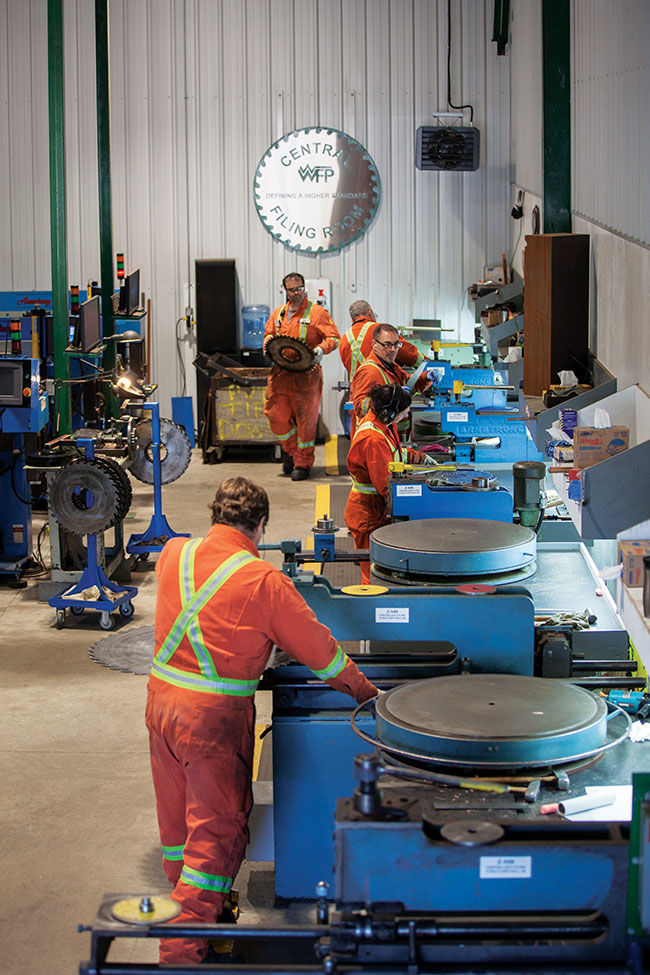 Western Forest Products recently opened a centralized filing room at its Saltair sawmill in Ladysmith, B.C. The filing room services their sawmills and reman plant on Vancouver Island. Photos courtesy Western Forest Products.
Western Forest Products recently opened a centralized filing room at its Saltair sawmill in Ladysmith, B.C. The filing room services their sawmills and reman plant on Vancouver Island. Photos courtesy Western Forest Products. It’s become a situation that all too many mills are familiar with. Filers are getting older and starting to make retirement plans. Apprentices take time to train and gain experience and, due to a gap in the B.C. filing school program a few years ago, an entire age group of young filers is largely missing. At the same time, tighter margins within the forest industry means efficiency is more important than it has ever been.
So what is a company to do when skilled sawfilers are hard to come by, but the demand for them has increased? I recently had the pleasure of touring Western Forest Products’ (WFP) central filing room at their Saltair division in Ladysmith, B.C., to see for myself how well their homegrown solution is working for them.
The idea of a centralized filing room servicing several mills is not a new one. It has been a topic of discussion around sawmill lunchrooms for quite a while and, like any unfamiliar concept, there is a lot of skepticism. “Are we going to go from being filers to saw packagers? How can it be cost effective to send saws all over the countryside? What happens when changes in the mill require adjustments to the saws?” These questions and many more are asked, but seldom is there any consensus as to the viability of the idea, so it remains primarily a hypothetical exercise. Until now, that is.
WFP was no stranger to the difficulties in recruiting new filing room staff. When the idea of a new centralized filing room was proposed, Derek Haupt, general manager of manufacturing, was charged with the task of investigating the possibilities. Derek found that WFP had several unique advantages that made the idea of a central filing room not only possible, but preferable to the current system of processing roundsaws independently in each division. The fact that their six sawmills and one reman plant are all within 45 minutes of the Saltair mill site is certainly a large key to the viability of a central filing room.
To get the ball rolling, Derek needed somebody to make it all happen; he found that in B.C. sawmill veteran Neil Morris. Neil started in the business 40 years ago at the age of 16. He has worked in 11 mills, spent 12 years as a head filer, and has been a maintenance superintendent as well as a plant superintendent. It’s safe to say that Neil has sawdust flowing through his veins and was therefore a perfect choice to take on a difficult project many thought couldn’t be done. Neil was appointed superintendent of saw filing across all of the WFP operations and he started hammering out the details to make the concept a reality.
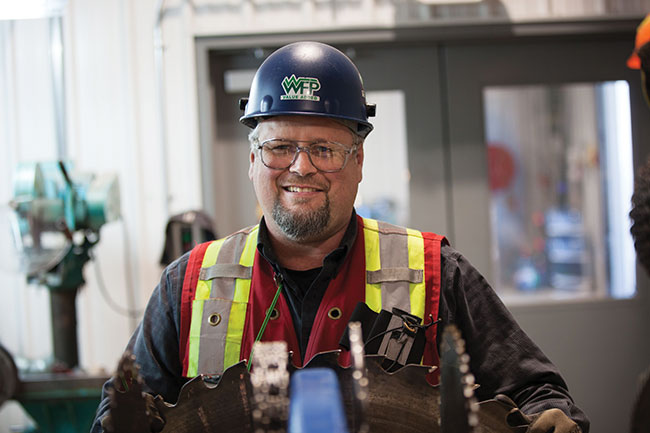
Neil Morris
The decision was immediately made to focus solely on circular saws. The logistics of packaging and transporting bandsaws was deemed too complicated. It was also decided early on that standardization would be an important contributor to the success of the program. Every circular saw that leaves the filing room would be a “WFP saw,” benched and sharpened to exacting specifications each and every time for safe, consistent results in every mill.
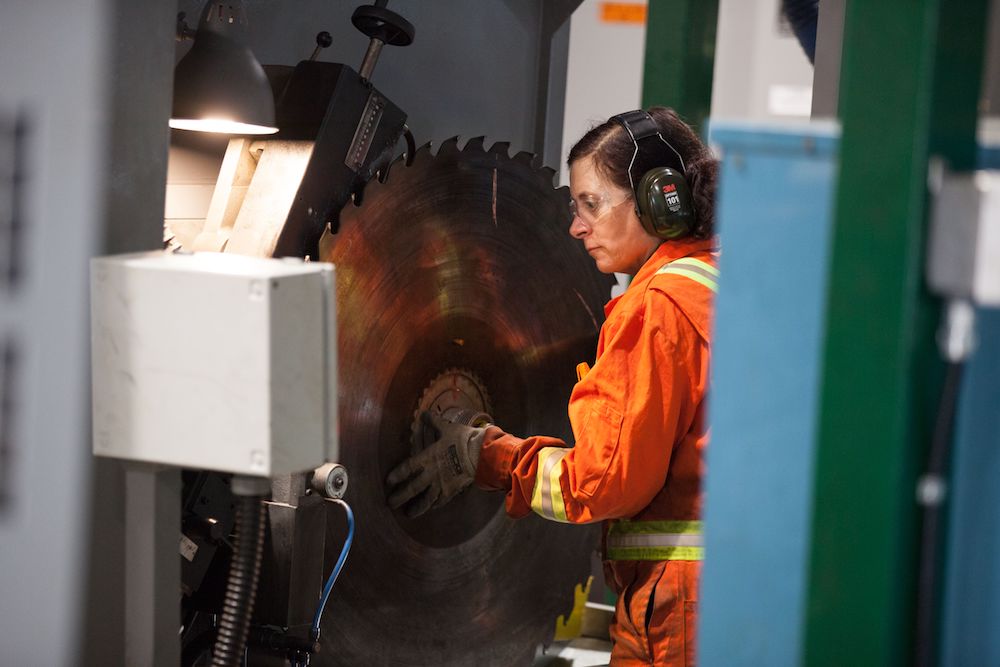
Photo courtesy Western Forest Products.
It is one thing to seek efficiency and repeatable excellence; it is another thing to achieve it. To get the job done, WFP built a completely new filing room and stocked it with the very best equipment available. All filers know that equipment is as individual as the people using it. What shows as 30 degrees on one machine might be one or two degrees different on another machine from the same manufacturer in another mill. In addition to that, filing room machinery ages and needs replacing regularly, which is never an inexpensive proposition. By building a central filing room, WFP shed 37 pieces of filing room machinery, including 17 top/face grinders alone! Add to that the sundries and consumables necessary to stock seven filing rooms, and you are looking at massive savings. It’s also inefficient to pay for four grinders capable of doing hundreds of saws a day and then use them at 25 per cent capacity in four different mills.
Another decision made early in the program was to purchase automated grinders and tippers rather than pick the best pieces from their filing room inventory. Anybody who has ever looked seriously at robotic loaders and automated equipment knows they don’t come cheap, so it came as a surprise to Derek and Neil when the accounting division was the first to suggest purchasing high-tech gear. Again, it was an easy decision based on economies of scale. A central filing room is able to use all of the capability automatic grinders provide. WFP is currently processing about 300 saws every day, but has the capacity to more than double that. When you factor in savings obtained by not having to maintain and replace the 17 grinders, you can understand why the accountants liked the idea.
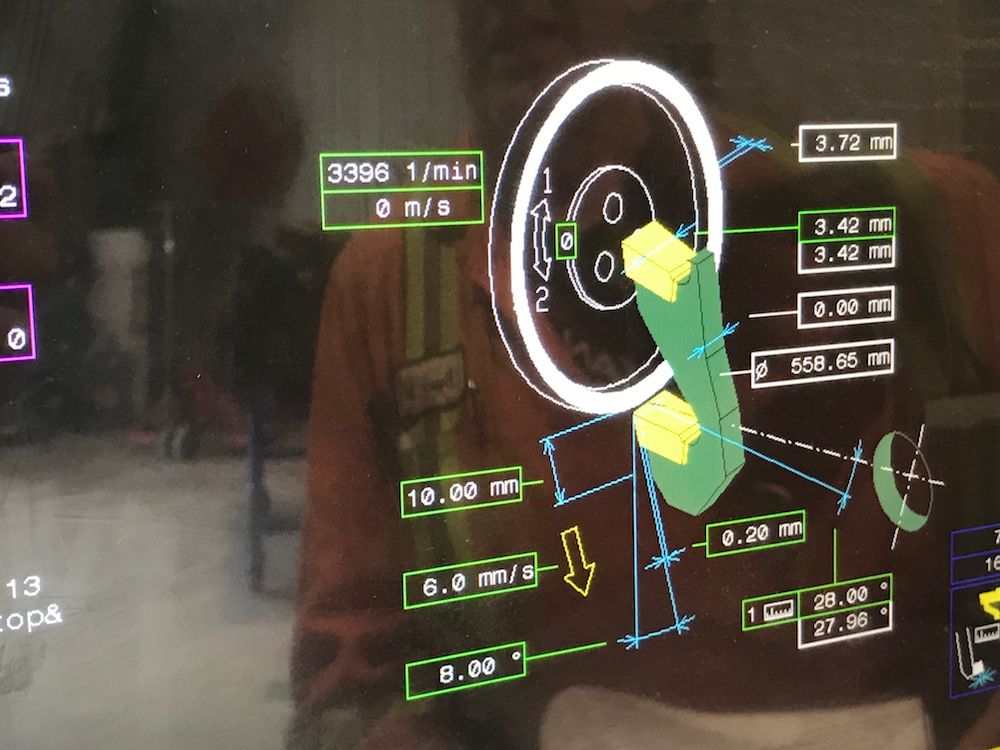
Photo courtesy Western Forest Products.
To help outfit the new filing room, Neil and Derek turned to Eric Gabara at HMT Machine Tools Canada. Eric has been a fixture in supplying quality filing room equipment for many years and was an easy choice to provide the state-of-the-art robotic grinders necessary to make the central filing room as efficient as it needed to be. Eric worked closely with Neil and Derek to ensure that the equipment they purchased was set up to meet their requirements. HMT’s Ken Annett and Brian Hass were also instrumental in ensuring that everything worked as it should.
When you first walk into the shop, it is impossible not to be startled by the sheer size of the cage containing the two Vollmer CHD 270 automatic top and face grinders and the CHF 270 automatic side dresser. The Vollmer ND360 robotics system that services the three grinders and its attendant carts is almost hypnotic to watch as it loads, unloads and stacks the saws all the way through the grinding process. The cage keeps employees at a safe distance from the working parts while the individual housings for the grinders prevent any environmental concerns due to airborne contaminants. Specially formulated high flash point oil replaces traditional grinding fluid and, since the machines are designed to run unattended, a full fire-suppression system and overhead explosion doors are in place.
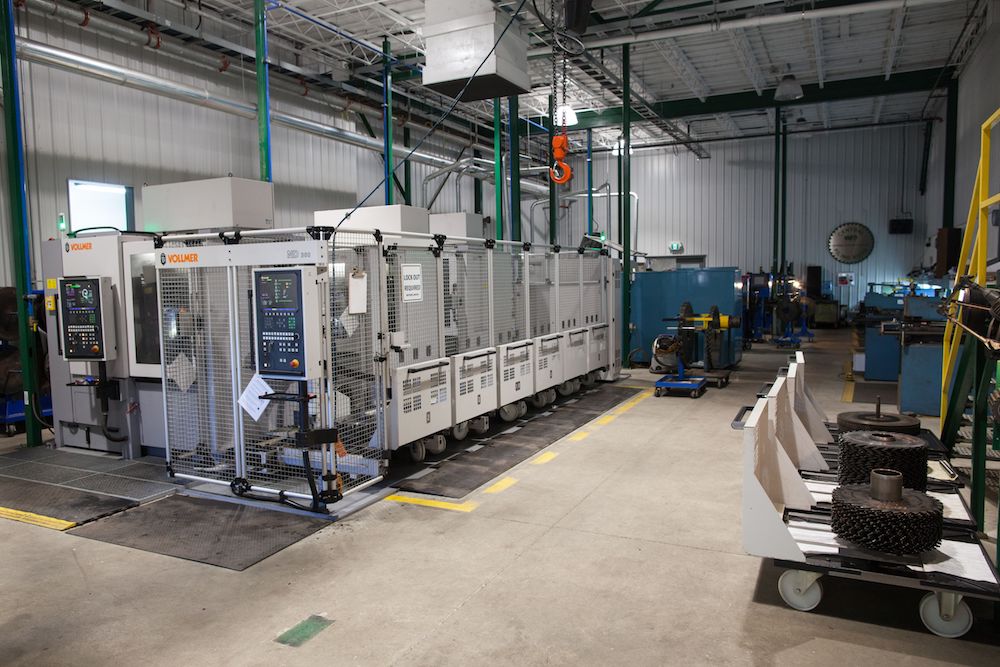
Photo courtesy Western Forest Products.
The CHD grinders are full CNC with probes that set each saw into exactly the right position. There is even a microphone that detects by sound if the saw is grinding properly and will stop the process and reassess if necessary. It is this consistency that helps make saw standardization possible.
In the early days of the new installation, Neil found that the saws from various divisions all had small discrepancies due to machine wear and individual eyes reading the dials, etc. It took a couple of weeks to run them all through, but now all saws are exactly the same, every time. As Derek says, “Robotics are the way to go for a modern filing room. If you hesitate you will get left behind.”
Another piece of new equipment is the Gerling Sawmaster tipper with robotic feed. With the capacity to do 300 saws in a 24-hour period and a proven track record for reliably placing the tips properly, the Gerling has proven to be a valuable addition to WFP’s automatic stable. A Kahny tipper handles the 36-inch reman saws, rather than trying to shoehorn them in among the regular saws.
There is plenty of other Vollmer equipment in the filing room as well. The CPF 200 and ECO side dressers are complimented by an ECO and four THC 20H top/face dressers. A Wright top grinder handles the v-topping needs as required. There are four Armstrong circular levellers taking some of the pressure off the filers and six Williams & White stretcher rolls adjusting the tension.
To move the saws between the mills, a flat deck truck makes the round-trip twice daily to deliver the sharp saws and pick up the dull ones. Neil constantly works with the head filers in all mills to remain responsive to change where change is required, and to experiment with new ideas so as to avoid stagnation and remain at the top of their game.
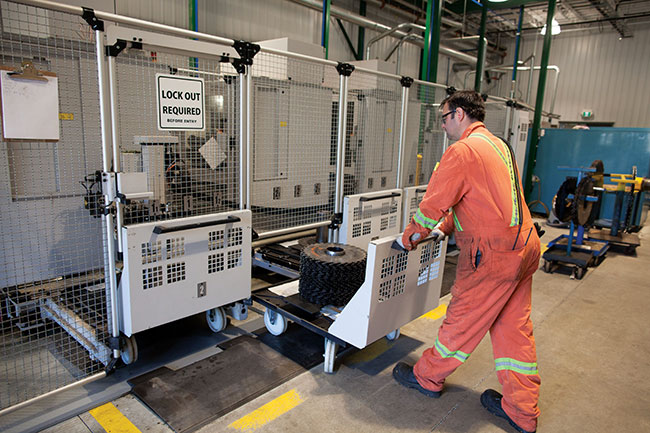
The central filing room is stocked with some of the latest in automation for saw filing, including this Vollmer ND360 robotics system. Photo courtesy WFP.
Another crucial component to the central filing room plan is the recruitment of new filers. With so few filers available, WFP has elected to “grow their own,” and to that end is currently training 18 apprentices. The new filers are selected from their home mills and receive their roundsaw training at Saltair. Apprentices team up with veteran filers in a mentorship program and are encouraged to speak up when they think they have a better way of doing something. In fact, the saw centre they use to mount the 36-inch reman saws on the Kahny tipper was designed by an apprentice. Sometimes new eyes see things experience might miss.
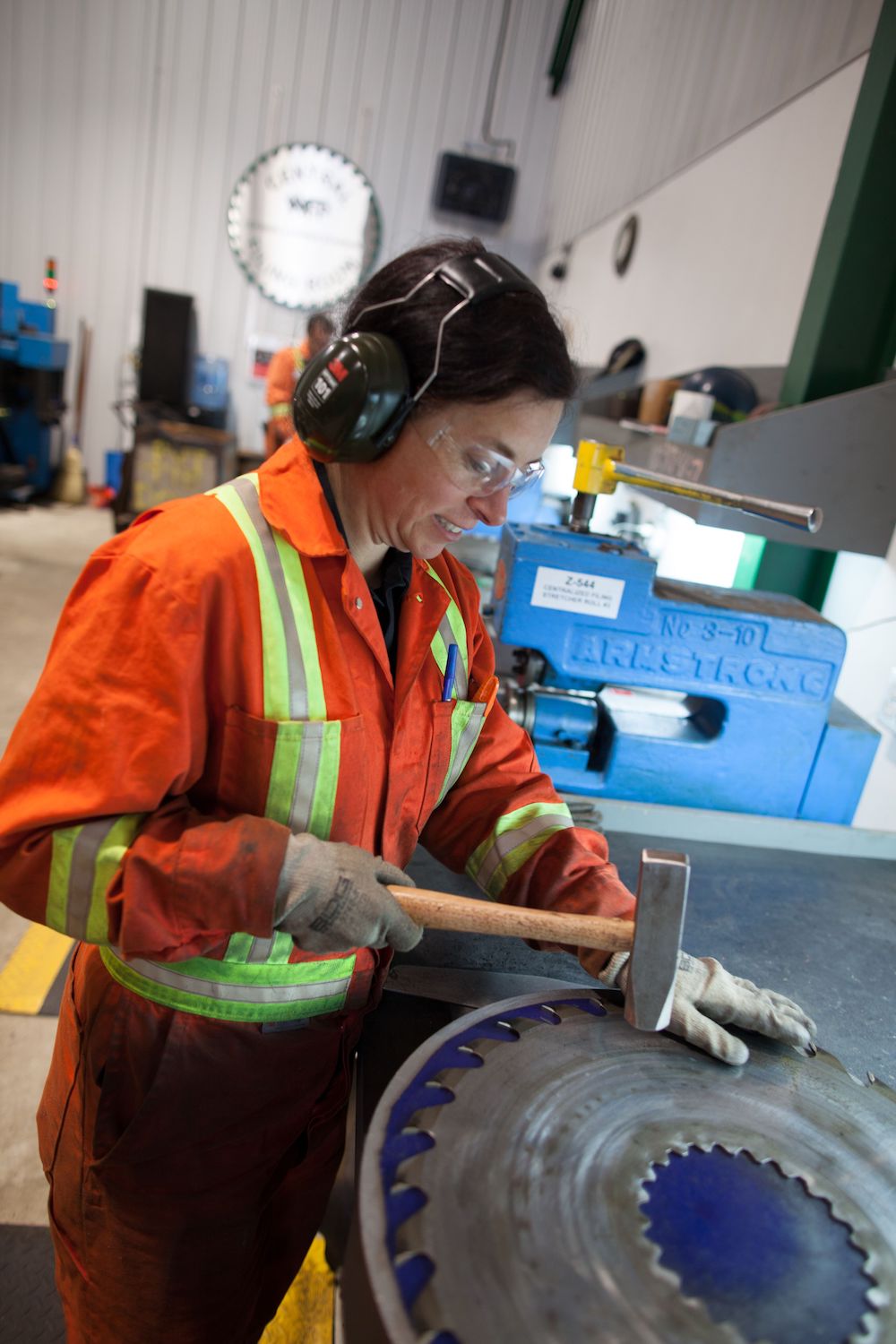
Photo courtesy Western Forest Products.
So has the road to a central filing room been smooth? Well, not always. There were growing pains, as can be expected anytime you are breaking new ground. Yes, there are fewer filers required, but that reduction is mostly accommodated by natural attrition as people leave the company or retire. There was some adjustment associated with standardization and the delivery of the saws, but, all in all, everything has run admirably well and there have been no serious disruptions due to hiccups. The reaction from the filers has been varied, of course, but as the system shakes into its groove, people are seeing the value and the necessity of the central filing room. The separate divisions are reportedly very happy with the way it has been working so far.
The savings and efficiencies achieved in a central filing room would be tantalizing to the CFO of any forest company, but does that mean that there is going to be a rush towards this type of system? Probably not. Most companies do not have the geographical advantages enjoyed by WFP, nor do they have the similarity of products that would allow for complete standardization across their mills. But there is no question it was the right decision for WFP and that it will be a very real consideration for some companies in the future.
Equipment matters
- Vollmer CHD 270 automatic top and face grinders
- Vollmer CHF 270 automatic side dresser
- Vollmer ND360 robotics system
- Gerling Sawmaster tipper with robotic feed
- Kahny tippers
- Vollmer CPF 200 side dresser
- Vollmer ECO side dresser
- Vollmer THC 20H top/face dressers
- Vollmer ECO top/face dresser
- Wright top grinder
- Armstrong circular levellers
- Williams & White stretcher rolls
We are looking for other filing rooms that would like to be profiled in this space. If you are interested, please ask your mill management for permission. The mill will always get final approval on the article before printing. I can be reached at
trevor.shpeley@gmail.com.
Print this page